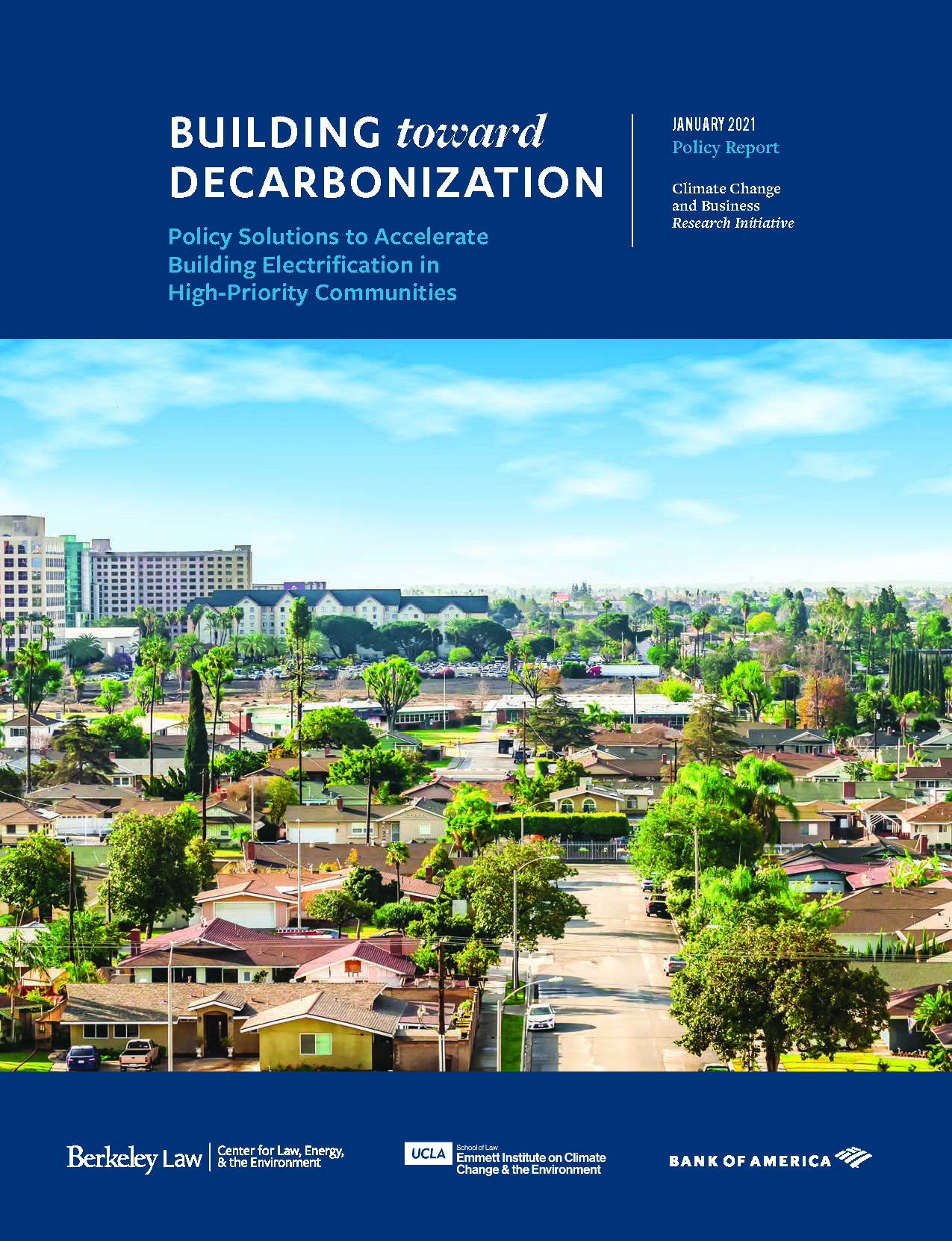Today, the Center for Law, Energy and the Environment (CLEE) at Berkeley Law and the Emmett Institute on Climate Change and the Environment at UCLA Law are releasing a new report, Building toward Decarbonization, which highlights the key barriers and policy solutions to accelerate building electrification retrofits and new construction in California’s high-priority communities.

Commercial and residential building consumption of natural gas—to power heating and cooling, water heating, and cooking equipment—is currently responsible for about 10 percent of California’s greenhouse gas emissions, as well as harmful indoor air pollution. Transitioning the state’s buildings from natural gas to all-electric—such as electric heat pumps, electric water heaters, and induction cooktops—is thus one of the top priorities for statewide decarbonization and carbon neutrality by 2045. Over 40 cities have already taken municipal action to phase out building natural gas use, including all-electric new construction ordinances in Oakland, San Francisco, and San Jose.
But the transition presents significant regulatory, economic, and infrastructure challenges.
Developing a statewide strategy and timeline for the transition will be essential to achieve state decarbonization goals, and as the new report describes, this strategy will be most effective if it is targeted first toward communities and building types that will benefit most from state support and incentives. These include:
- Lower-income and disadvantaged communities with the least financial resources and the most to gain from improved air quality;
- Communities currently investing in new building construction;
- Communities with aging gas infrastructure already in need of replacement;
- Communities with an expressed willingness to transition; and
- Communities rebuilding from recent wildfires.
In a state that chronically under-builds new housing and will still have millions of pre-1990 homes in place in 2050, the retrofit challenge is especially urgent. And retrofitting existing buildings in lower-income communities—which tend to have more renters, more multifamily buildings, older construction, and less available capital—is a particularly thorny challenge: replacing gas HVAC, water, and cooking systems with all-electric alternatives can save money in the long run, but upfront installation costs are high, and landlords may have limited incentives to upgrade appliances when they aren’t responsible for utility bills. In addition, existing utility business and regulatory frameworks can limit incentives to accelerate the transition (or in some cases may bar the removal of gas service), compounding the after-effects of a long history of service denial in some communities.
All of these challenges overlay the systemic risk of developing stranded assets in the natural gas distribution network if the transition is insufficiently structured, which could threaten the financial viability of utilities, physical safety of the system, and costs for customers who can’t afford to make the switch independently.
Fortunately, state leaders have an opportunity to address these challenges by developing a reasoned plan to manage the electrification transition in order to meet state climate goals and address the needs of stakeholders including high-priority communities and natural gas system workers. Building Toward Decarbonization recommends these priority solutions:
- Setting a clear timeline (via executive order or legislation) for the long-term phase-out of natural gas to provide certainty for utilities and investors and mitigate stranded asset impacts on customers.
- Clarifying electric and utilities’ legal “obligation to serve” to ensure that electrical service can be substituted for gas service so long as energy access is maintained.
- Crafting a structured plan for a just transition for gas system workers including funding, retraining support, and targeted early retirement opportunities.
- Communicating the air quality benefits and performance qualities of electric stoves, hot water heaters, and other equipment to build public support for the transition.
Ultimately, California’s achievement of carbon neutrality by 2045 will hinge on this transition, particularly as the state continues to advance its goal of system-wide resilience through load management and flexibility.
You can read the full report here.
To learn more about potential solutions to accelerate the building electrification transition, register for our free webinar on Tuesday, February 23 at 1pm. Speakers include:
- Michael Colvin of Environmental Defense Fund
- California Public Utilities Commissioner Cliff Rechtschaffen
- Abigail Solis of Self Help Enterprises
They will join us to discuss priorities and opportunities for the coming decade of the decarbonization effort. Register here.
This post is co-authored with Ted Lamm and cross-posted on Legal Planet.


